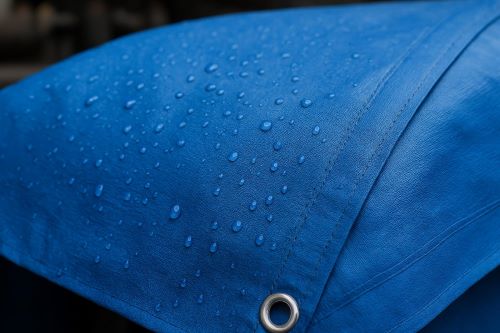


The material is subjected to greater physical stress during farming. Animal traffic, strong weather, sharp equipment
Farms expose equipment and resources to outdoor conditions daily. From storing harvested grains to creating shade for livestock, the need for a durable and versatile tarpaulin is constant.
A good tarp should:
Unlike tarps used in construction or households, farm tarps must remain flexible even after repeated folding and unfolding. Material memory, seam strength, and UV resistance are critical in daily usability.
GSM stands for grams per square meter and directly relates to the thickness and durability of the tarp. In farming, selecting the correct GSM determines how long the tarp will last outdoors.
|
GSM Range |
Ideal Usage Type |
Lifespan (Avg.) |
|
90–120 |
Temporary coverage, single-use |
1–3 months |
|
150–200 |
Short-term rain protection |
3–6 months |
|
250–300 |
Farming equipment & grain cover |
12–24 months |
We tested a Black HDPE 250 GSM Plastic Tarpaulin on open tractors and fertilizer storage bins for two complete monsoon cycles. It held up without cracks, corner tears, or water leakage, showing why mid-GSM tarps are best for Indian field conditions. These tarps also work well on uneven surfaces, like plowed ground or stacked grain bags.
Farming needs vary from region to region. Dry areas may need shade protection. Wet regions require waterproofing. Here’s how tarp selection changes based on use case:
|
Application |
Recommended GSM |
Additional Features Needed |
|
Seed & grain storage |
250–300 |
Anti-fungal coating |
|
Tractor & equipment |
250+ |
UV + Water resistance |
|
Silage covering |
300+ |
Heavy GSM + corner reinforcements |
|
Livestock shelters |
200–250 |
Breathable + lightweight tarp |
The farming environment demands a tarp that’s rugged but manageable. Among the popular materials used in tarps:
Due to its ability to combine strength and convenience, HDPE has emerged as the preferred choice. For field deployment, you need something that can be handled by one person and will not tear when it comes into contact with a thresher or a harrow.
“The value of a tarp isn’t in how it looks when new, it’s in how it performs after a storm.”
While waterproof tarps are great for most farm applications, specific use cases like composting or animal shade require some airflow.
Choose waterproof tarps for:
Choose semi-breathable or canvas tarps for:
HDPE offers a middle ground: decent air control without full sealing, which is ideal for general farming needs.
A quality tarp costs more, but repeated purchases of cheap ones cost even more. A ₹700 low-GSM tarp might last 2 months, while a ₹1200 mid-GSM tarp lasts over a year.
In our use cases, tarpaulins above 250 GSM resulted in:
The numbers clearly show that a wise investment up front saves money later.
A strong tarp poorly tied is as good as no tarp. For farm setups, use:
Wind stress can quickly tear corners and eyelets. Even the best tarp needs a strong anchoring method to hold it through the storm.
Each farm’s needs are unique. Start modestly by covering your most vulnerable asset with a single, high-quality tarp. Observe how it responds to wind, rain, and frequent use. Look for signs of sagging edges, eyelet wear, or fold marks.
After a testing season, you will be able to determine the ideal GSM, size, and construction for your land.
The right tarpaulin doesn’t just cover – it protects your livelihood, one sheet at a time.
